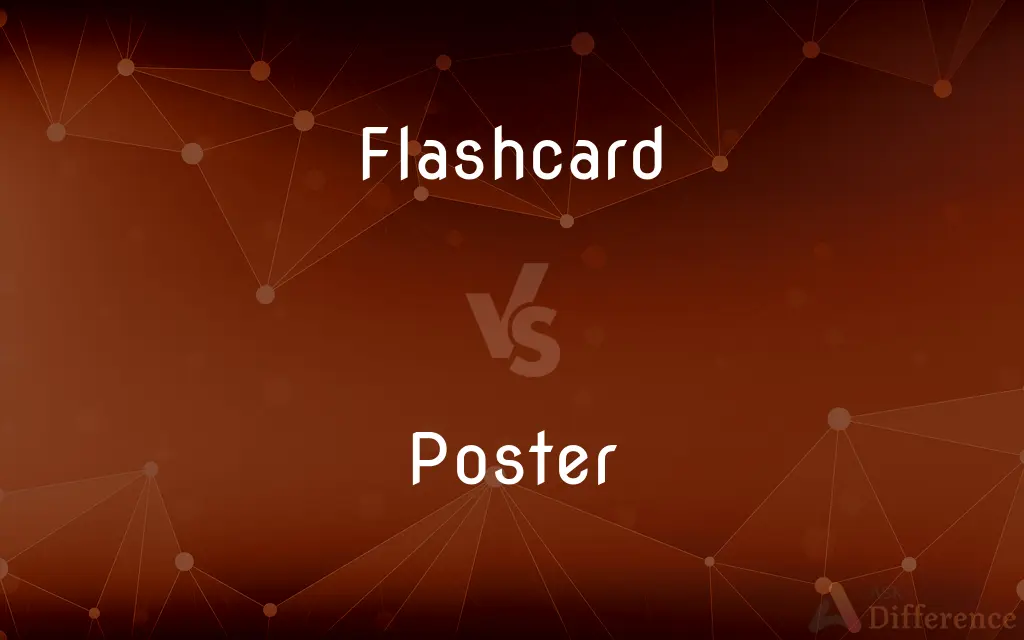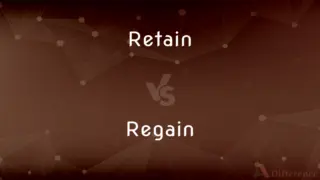Flashcard vs. Poster — What's the Difference?
By Tayyaba Rehman & Maham Liaqat — Updated on April 2, 2024
Flashcards are small, portable cards used for studying and memorizing, while posters are large prints designed for informational or promotional display.

Difference Between Flashcard and Poster
Table of Contents
ADVERTISEMENT
Key Differences
Flashcards are a study tool consisting of small cards bearing information, such as terms and definitions or questions and answers, on either side. They are used for learning and memorization, employing spaced repetition and active recall techniques. Posters, on the other hand, are large printed materials designed to convey information or advertise a product, event, or service visually. They are intended for public display and can incorporate text, images, and graphics to attract attention or deliver a message.
While flashcards are primarily educational and personal use tools, focusing on the individual's learning process, posters are used in both educational settings and marketing to communicate messages to a broader audience. Flashcards facilitate one-on-one or self-directed learning, helping users internalize concepts or vocabulary. Conversely, posters aim to inform, persuade, or decorate, serving as a one-to-many communication tool.
The design of flashcards is simple and functional, with the primary goal of enhancing memory retention and recall. They are typically hand-held and can be written on or printed. Posters, however, are more diverse in design, ranging from minimalist to complex, with the intent to catch the eye of passersby. They are usually mounted on walls or other surfaces where they can be easily seen by many people.
In terms of content, flashcards are focused and concise, presenting information in a format that is easy to digest and review. This makes them particularly effective for language learning, exam preparation, and other educational purposes. Posters, however, can cover a wide range of content, from detailed explanations and instructions to simple slogans or visuals, depending on their intended use and audience.
The use of flashcards and posters reflects different approaches to information delivery and learning. Flashcards engage the user in an active learning process, requiring interaction and mental effort to review and recall information. Posters, by contrast, rely on passive engagement, where the viewer absorbs information presented visually without direct interaction.
ADVERTISEMENT
Comparison Chart
Purpose
For studying and memorizing information.
To inform, advertise, or decorate.
Use
Personal or small group learning.
Public display in educational, commercial, or public spaces.
Design
Simple and functional, often double-sided.
Diverse, often visually striking and single-sided.
Content
Focused and concise, suited for quick review.
Can be detailed or minimalistic, designed for visual impact.
Interaction
Requires active engagement for learning.
Provides information through passive viewing.
Compare with Definitions
Flashcard
A flashcard is a small card used for learning, with information like vocabulary or questions.
She used flashcards to memorize Spanish verbs.
Poster
A poster is a large printed material designed for wall display, often for informational or promotional purposes.
The event poster was hung at the entrance to attract attendees.
Flashcard
They are portable and convenient for on-the-go study sessions.
He carried a set of flashcards for quick review before the test.
Poster
Used in various settings, including educational, commercial, and public spaces.
Movie posters outside the cinema showcased upcoming releases.
Flashcard
Flashcards aid in memory recall through active engagement.
Reviewing flashcards daily improved his understanding of biology concepts.
Poster
Can incorporate both text and graphics for eye-catching design.
The charity event poster featured bold colors and compelling images.
Flashcard
Often used in language learning and exam preparation.
Flashcards with GRE vocabulary words were key to her study routine.
Poster
Posters can visually communicate messages to a broad audience.
The safety poster in the lab reminded students to wear goggles.
Flashcard
Can be created manually or digitally.
She downloaded a flashcard app to study for her chemistry exam.
Poster
Serves as decoration, advertisement, or information dissemination.
Vintage travel posters decorated the café, creating a thematic ambiance.
Flashcard
A flashcard or flash card is a card bearing information on both sides, which is intended to be used as an aid in memorization. Each flashcard bears a question on one side and an answer on the other.
Poster
A poster is a temporary promotion of an idea, product, or event put up in a public space for mass consumption. Typically, posters include both textual and graphic elements, although a poster may be either wholly graphical or wholly text.
Flashcard
A card printed with words or numbers and briefly displayed as part of a learning drill.
Poster
A large, usually printed placard, bill, or announcement, often illustrated, that is posted to advertise or publicize something.
Flashcard
(Computers) A memory card that uses flash memory.
Poster
An artistic work, often a reproduction of an original painting or photograph, printed on a large sheet of paper.
Flashcard
A card used to aid rote memorization. One side of the card contains data of one kind, or a question, and the other side contains the associated response which one wants to memorize. For example, one side could contain an English word, and the other side the Spanish translation.
Many people use flashcards to learn languages.
Poster
One that posts bills or notices.
Flashcard
(electronics) A solid-state digital memory storage format, commonly found on computers, digital cameras and cellphones.
Poster
One that travels in speed or with haste.
Flashcard
A card with words or numbers of pictures that are flashed to a class by the teacher
Poster
A picture of a celebrity, an event etc., intended to be attached to a wall.
He has posters of his favorite band, sports teams and holiday resorts up.
Poster
An advertisement to be posted on a pole, wall etc. to advertise something.
I saw a poster for the film on the side of a bus.
Poster
(internet) One who posts a message.
Some posters left the online message board after the squabble.
Poster
A shot that hits a goalpost, scoring one point.
Poster
A shot that hits a goalpost instead of passing into the goal.
We got three posters in the third and lost.
Poster
(basketball) A dunk over a defending player.
Poster
(dated) A posthorse.
Poster
(archaic) A swift traveller; a courier.
Poster
(transitive) To decorate with posters.
To poster the walls of a bedroom
Poster
A large bill or placard intended to be posted in public places.
Poster
One who posts bills; a billposter.
Poster
One who posts, or travels expeditiously; a courier.
Poster
A post horse.
Poster
A sign posted in a public place as an advertisement;
A poster advertised the coming attractions
Poster
Someone who pastes up bills or placards on walls or billboards
Poster
A horse kept at an inn or post house for use by mail carriers or for rent to travelers
Common Curiosities
Where are posters commonly displayed?
Posters are commonly displayed in educational institutions, commercial spaces, public areas, and at events.
What is the primary use of a flashcard?
Primarily for studying and memorizing information through active recall and spaced repetition.
What distinguishes a poster?
Posters are distinguished by their large size and visual design, intended for informational, promotional, or decorative purposes.
Can flashcards be digital?
Yes, digital flashcards are popular, allowing for interactive learning and easy access on various devices.
How do posters attract attention?
Posters attract attention through visual elements such as bold colors, compelling images, and clear, impactful text.
Can flashcards be used for group study?
Yes, flashcards can be used for group study, promoting interactive learning and discussion.
How do flashcards aid in learning?
Flashcards aid in learning by facilitating active recall, which enhances memory retention and recall of information.
Are flashcards effective for all subjects?
Flashcards are versatile and can be effective for a wide range of subjects, especially those requiring memorization of terms, definitions, or concepts.
Can anyone create a poster?
Yes, with access to design tools and printing services, anyone can create a poster for various purposes.
What is the best way to use flashcards for studying?
The best way is to use them in spaced repetition cycles, reviewing the cards at increasing intervals to improve long-term memory retention.
How can posters be used in marketing?
In marketing, posters can advertise products, services, or events, targeting specific audiences in high-traffic areas.
What types of content are suitable for posters?
Content ranging from advertising and educational material to artistic and decorative imagery is suitable for posters.
What materials are used to make posters?
Posters are typically printed on paper or cardstock, but can also be produced on other materials for durability or outdoor use.
What is the environmental impact of using flashcards and posters?
The environmental impact depends on the materials used and disposal methods, with digital options for flashcards reducing waste and sustainable materials available for posters.
How are flashcards and posters similar?
Both can serve educational purposes, with flashcards focusing on individual learning and posters on conveying information to a wider audience.
Share Your Discovery

Previous Comparison
Retain vs. Regain
Next Comparison
Possible vs. AvailableAuthor Spotlight
Written by
Tayyaba RehmanTayyaba Rehman is a distinguished writer, currently serving as a primary contributor to askdifference.com. As a researcher in semantics and etymology, Tayyaba's passion for the complexity of languages and their distinctions has found a perfect home on the platform. Tayyaba delves into the intricacies of language, distinguishing between commonly confused words and phrases, thereby providing clarity for readers worldwide.
Co-written by
Maham Liaqat














































